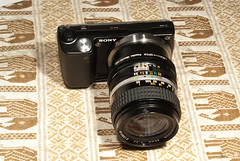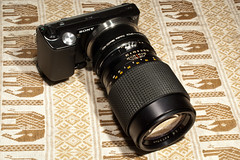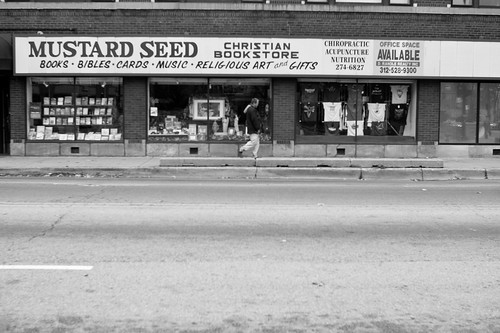At the same time, mounted with these big manual lenses, the NEX looks a lot like Sony’s pro-sumer so-called “bridge cameras” from the early and mid 2000s. Models like the F707 and F828 both feature a non-detachable large lens barrel attaches to a relatively small camera body. Sony also used a similar design for their first large sensor camera, the R1. In many ways the R1 is the closest predecessor to the NEX line, in that the R1 featured an APS-C sized sensor, just like most dSLRs, but without a mirror-reflex viewfinder, using a small electronic viewfinder (EVF) and rear LCD, like the NEX. Unlike the NEX the R1 had a fixed, non-interchangeable zoom lens, and so the camera as a whole was much bigger, and SLR-like in dimensions.
Being able to mount lenses of all different brands and mounts was one of the features that really attracted me to the NEX, and using these F-mount lenses on the NEX-5 was no disappointment. Although this requires that you manually select your aperture on the lens and also manually focus, I found this to be no more difficult than using an older manual film SLR. The NEX lets you magnify the view on the LCD by 7x or 14x which greatly helps in getting very accurate focus. I often enjoy using manual film cameras because they force you to slow down and focus on getting the image rather than having the camera set everything and just blasting away. Thus I really enjoyed having this manual-camera experience with my digital NEX on this photowalk.
Most old manual focus lenses have a distance scale printed on them, so you can easily set them for particular focus distance ahead of time, and then just fine tune when you need to. This is the way many users of rangefinder cameras shoot, especially when street shooting, where capturing the “decisive moment” is more important that perfectly accurate focus and exposure. In fact I was pleased with some grab shots I got with guesstimated focus, like this one below, which was featured on the Chicago news and culture blog, Chicagoist:
Shooting with an old manual lens means that you don’t interact with the NEX’s control interface and menus very much, except to set ISO and to magnify the image on the LCD. Using such a lens wouldn’t be my choice for shooting events or other situations where I need to obtain accurate focus quickly. Nevertheless, it’s a very nice experience.
The Fotodiox F-mount adapter I used works very well, mounting very surely to both the NEX and the lens. With these manual lenses you just move it’s aperture level to “lock,” and then you’re ready to select the aperture using the lens. With the adapter you get a very WYSIWYG experience on the LCD, getting an effective depth-of-field preview because the lens is already stopped-down. On modern SLRs the aperture only stops down when you press the shutter, therefore what you see in the viewfinder is always the lens at its maximum aperture. In order to compensate for the reduced light coming through the lens the NEX brightens the LCD. I primarily shoot aperture-priority, so the camera still chose the shutter speed, which I adjusted using exposure compensation. But, by and large, I found the NEX’s meter to be very predictable and spot-on most of the time, barely needing any compensation even when shooting something against the sky.
The physical balance of the camera with either of these two lenses wasn’t too bad, though the large 135mm lens felt heavy after a while. Given that one of the big pluses of the NEX is its small size and weight, the 135 will not be a frequent choice for me, except for those rare occasions when I want a camera with that kind of telephoto reach at a still reasonable size. The Nikkor 28mm lens felt more reasonable and therefore made for a more pleasant shooting experience.
Still, I would prefer to find a prime lens of a normal focal length on the NEX that is smaller and lighter, more proportionate to its body. Currently Sony doesn’t offer anything like that in the native E-mount, but it’s a young camera model. Sony does offer an inexpensive 35mm f/1.8 lens in the Alpha mount for its Alpha line of dSLRs, which will work with the NEX using an adapter. While the Sony 35mm is relatively light weight, combined with the a-mount adapter it will still be fairly long, at about 78mm or nearly 3 and a quarter inches. The advantage of this combination, of course, is that I could use the same lens on my a100 dSLR.
An alternative option I’m considering is the Voigtlander 35mm or 40mm f/1.4 lens in the Leica M-mount. Because they’re designed for rangerfinder cameras that have shorter flange than SLRs, which makes for a smaller lens. Similarly, the adapter for an M-mount lens is also shorter and lighter, making for a smaller overall package.
Finally, I also enjoyed using the Sony 16mm e-mount lens on this photowalk. Having now set my autofocus point to the center I got very predictable focus compared to the multi-point autofocus that I complained about in my first post about the camera. Though many reviewers and commentators complain about the lack of sharpness and distortion at the edges with this wide lens, I find that if you take that into account when framing your shot (and you do see the distortion on the LCD), then it isn’t much of an issue. In fact, many people go out of their way to add softness and vignetting at the corners of their images in Photoshop after the fact. So, really, it’s about what kind of image you’re looking to produce and choosing the lens that will produce it. That said, both Photoshop and Lightroom have lens correction presets for the lens that work quite well.
In the image above the slight vignetting and lack of sharpness at the corners helps to focus the viewer’s attention on the center of the image, where the subject is. This image also highlights something else I liked about using the NEX-5, the movable LCD display. For this picture I set the camera on the ground and flipped the LCD up so I could see it from above. This way I didn’t have to lay on the ground in order to frame it properly. This would have been a more difficult shot to get with an SLR where I would have either had to lay on the Chicago streets or guess my framing.
One of my few complaints after using the NEX-5 for a few weeks is its start-up time. I haven’t taken a stopwatch to it, but I’d say it takes nearly 15 seconds, if not longer, for it to fully start up after turning it on. This is slow even compared to a point-and-shoot camera that has to open up a lens door and move the lens out with a motor. It’s absolutely glacial compared to a dSLR. I still find my self wondering if the battery is dead or not in there after turning it on because I’m not used to waiting so long. It’s a very minor gripe, but something I hope Sony can address with a firmware update.
I did shoot a little bit of video with the F-mount lenses, though nothing critical. I just wanted to test out the ability to manually rack focus and control the focus point using depth of field. This was easiest using the 135mm lens which has a very slow and precise focus ring. I suspect this would be easier with an M-mount lens, like the Voigtlanders, because they have a tab on the focus ring. Of course, those who are serious about racking focus add a follow-focus rig to their camera.
In any event, here’s a very short video demonstrating this technique on the NEX-5 with the Nikkor 28mm f/3.5 lens:
Of Fences and Depth of Field from Paul Riismandel on Vimeo.
The real test of a camera is using to shoot for an extended period of time. Now that I’ve had the chance to get out for a good, long photowalk, I’m quite happy with the NEX-5. It does not quite replace an SLR for situations where you need very fast autofocus or long telephoto reach, or where using a viewfinder is most appropriate. Nevertheless, it’s a great combination of compact-camera size and weight with dSLR image quality.
I’ll continue to write updates as I use the camera more.






Very instructive post. I’m interested in getting a NEX5 mainly for a video purpose with my F mount (AI, AF, and G) lenses.
Your opinion on the Fotodiox mount adapter and the sample pictures and video will certainly help me decide 🙂
Hey.. Very interesting post there you got.. But I’m quite new in photography and I have a nex5 as well.. I was wondering whether is it possible for the nex to use all those telephoto and zoom lenses such as nikon?.. because i have a nikon mount adapter and I am still deciding which lens to get..
Very good post!
Reflects pretty much my experience with the NEX-5 with manual lenses (Canon FD 50mm f/1.4). Now photography makes much more fun! Shallow DOF gives a kind 3D in your pictures. It´s a challenge though when you photograph people. How fast can you manually fucus a f/1.4 lens…and I am getting faster with every shot. (hopefully)
SteadyShot doesn’t work with non-e lenses I assume?
Steady shot is not built into the body, and only some e-mount lenses have it. Image stabilized Nikon f-mount lenses will not be stabilized with the adapter on the NEX.
Hello,
I’m looking for a camera. I was drawn to the compact interchangeable lens ones. I like that they are small enough to fit in my purse but claim to take amazing photos. I was wondering if you had a favorite and why? I read that Nikon’s one takes more photos a second, however Sony’s camera seems to have some better lenses and easier to use options. (Is a detachable flash that big of a deal? Is is better at all?) I simply want to take some good photos- clear and crisp with true to life color, without delays (don’t want to miss a shot!) Would a larger SLR camera be that much better? It’s much bulkier and heavier, but is the quality noticeably better?
Thanks so much- sorry to bother you,
Jay
Hi,
I’m surprised you regard 15 second start-up time a minor gripe. More like an indication there’s something wrong with your camera – my NEX 5 is ready in less than two seconds.
I was unable to shoot any frama because the nex n5 did not recognize the lens and the shutter didn’t work
Any ideas?
Same problem for me. Tried two Nikon lenses with adapter only for nex 5 to say does not recognize lens pls check fitted correctly. Any help appreciated. Thks
Same problem for me. Tried two Nikon lenses with adapter only for nex 5 to say does not recognize lens pls check fitted correctly. Any help appreciated. Thks very much
The same problem here. I wonder if the Sony original adapter has some sort of electrics that others don’t have.
Jose, rdl, and Louis: To use Nex5 with nikkon or canon lenses, you have to enable shutter release without lens in set up.
hi,
can you do peaking with nikon lenses?
thx,
john